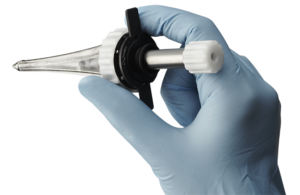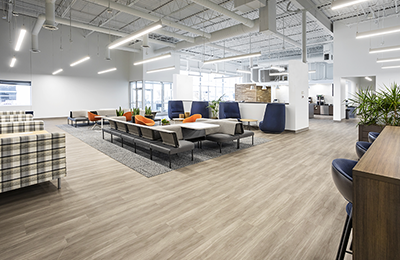Medtech contract manufacturers such as Minnetronix often avoid making their own devices. But CEO Jeremy Maniak had a different idea.

Minnetronix’s first product — the MindsEye Expandable Port — earned the “Best New Technology Solution – Surgical” award from MedTech Breakthrough, an independent market intelligence. [Image courtesy of Minnetronix]
Minnetronix Medical (St. Paul, Minn.) is closing on its quarter-century mark, and Jeremy Maniak has been with the company more than half of that time. Promoted into the corner office in early 2020, he has some unique ideas about how to position the medtech contract manufacturer for growth over the next 25 years.
An electrical engineer who entered the medical device industry directly out of Purdue University, Maniak explained to our DeviceTalks Weekly Podcast about how Minnetronix saw an opportunity to create its own line of medical devices. It was a move that some might see as a potential conflict with larger manufacturers who pay the company to develop, test and manufacture their own medical devices.
(Check out the latest DeviceTalks Weekly Podcast with Maniak on Friday, June 25, 2021.)
Minnetronix already has established itself as a contract manufacturer with a focus on four core technologies — radio frequency, electronic magnetics, optical device, and fluid and gas management. And the company has innovated well. Its first product — the MindsEye Expandable Port for minimally invasive deep brain access — earned the “Best New Technology Solution – Surgical” award from MedTech Breakthrough, an independent market intelligence. Meanwhile, Minnetronix’s second neurovascular product is still passing through regulatory inspection.
The following Q&A represents only a portion of the interview. It has been edited heavily for presentation and clarity.
DTW: When did you first contemplate developing your own products?
Maniak: When I joined the company, my mission was to identify whether there was an opportunity to [develop niche products.] We wondered if there are some other things we can do to help customers grow their businesses and ultimately help patients and doctors.
DTW: What was the genesis of this program?
Maniak: We really saw it as an opportunity to fill what we consider to be an innovation gap in middle markets of the medical device space. In this case, it’s in the neuro ICU space. We wouldn’t try to innovate in diabetes or cardiology, those big spaces with tons of venture capital and OEMs that are actively innovating in the space. We saw a gap in [products] with markets in the $500 million dollar range.
DTW: Developing your own line of products sounds transformational for a contract manufacturer. How do you see it?
Maniak: We see it as additive. We see it as an extension of what we do today. We’re not trying to shift from one business to the other. We view as an extension of our relationship with our partners. We don’t really have the intention to sell commercially at scale. We don’t have a direct sales force to the hospitals. We’re not planning necessarily on building one. That’s where we work with our partners.
DTW: How did you create the innovation infrastructure? Did you look internally or externally?
Maniak: Both. We definitely had some engineers here that were doing some of this sort of work for customers in different segments of medical technology. Then we also brought in some key folks around regulatory. We have a really nice partnership with Dr. [Andrew] Grande of the University of Minnesota as well as neurosurgeons from across the country.
DTW: Do your customers see a conflict in you developing your own medical devices?
Maniak: If we were competing in the sales channel against them, it’s possible. We’re not trying to compete with them. That’s not the purpose here. The purpose here is to give our partners more things to help their growth, which helps our growth and then helps patients. So it’s pretty symbiotic. Some people have tried this in the past. That’s been more of a competitive thing. Competing with customers doesn’t work. And that’s not what we’re doing.
DTW: Would you develop products that require a 510(k) or PMA?
Maniak: I think the PMA timelines are so long, and it actually undermines our middle market funnel a little bit. They just need to be really big opportunities to support the cost of a PMA.
DTW: What has this program taught your employees?
Maniak: We are in the contract business, the partnering business. I think it’s helped them put our customer’s challenge into context. They know what our customers are challenged with. They got to see that, `Hey, when we did it ourselves, where we have the same challenges and those are real challenges.’ I think it helps us work with our customers better across all of our products. It’s about how could we help you figure this out. It changes the conversation.

“We needed to expand, but at the same time, we wanted a place where culturally our employees want to be,” Minnetronix CEO Jeremy Maniak said of the company’s headquarters campus renovation. [Image courtesy of Minnetronix]
DTW: What has surprised you?
Maniak: It’s actually created some interesting discussions with customers and new customers that I wouldn’t have considered before like venture capitalists who are asking if they were to give us an idea from their think tank could we then create the product for them. They would obviously own the IP.
DTW: Finally, this is more of a bricks-and-mortar question. Your recently renovated headquarters looks sharp – basketball courts, cool workspaces – what does it say about where Minnetronix is headed?
Maniak: We needed to expand, but at the same time we wanted a place where culturally our employees want to be. It promotes collaboration, promotes innovation, promotes unity, and working together to solve the tough problems that exists with working with these technologies. Now we have someplace we can bring customers, and they can feel that same vibe. They can play basketball over lunch. They want to come in and partner with us. We want it to be fun, and we want an environment that really is engaging for them and our teams to, to work on these problems together.